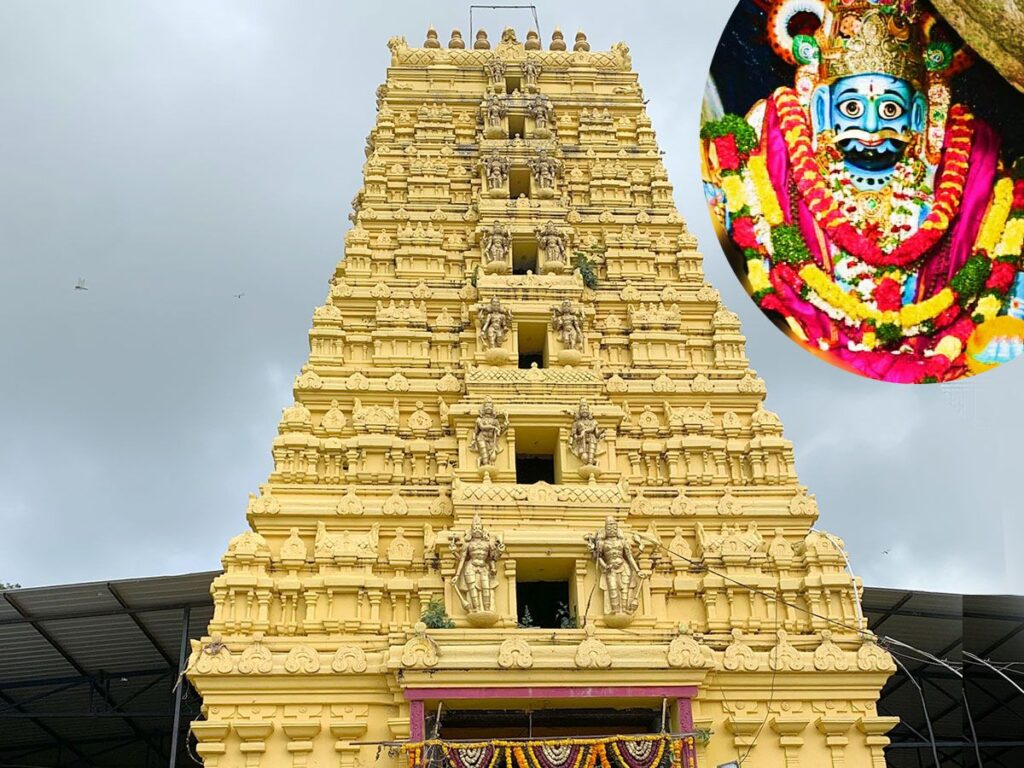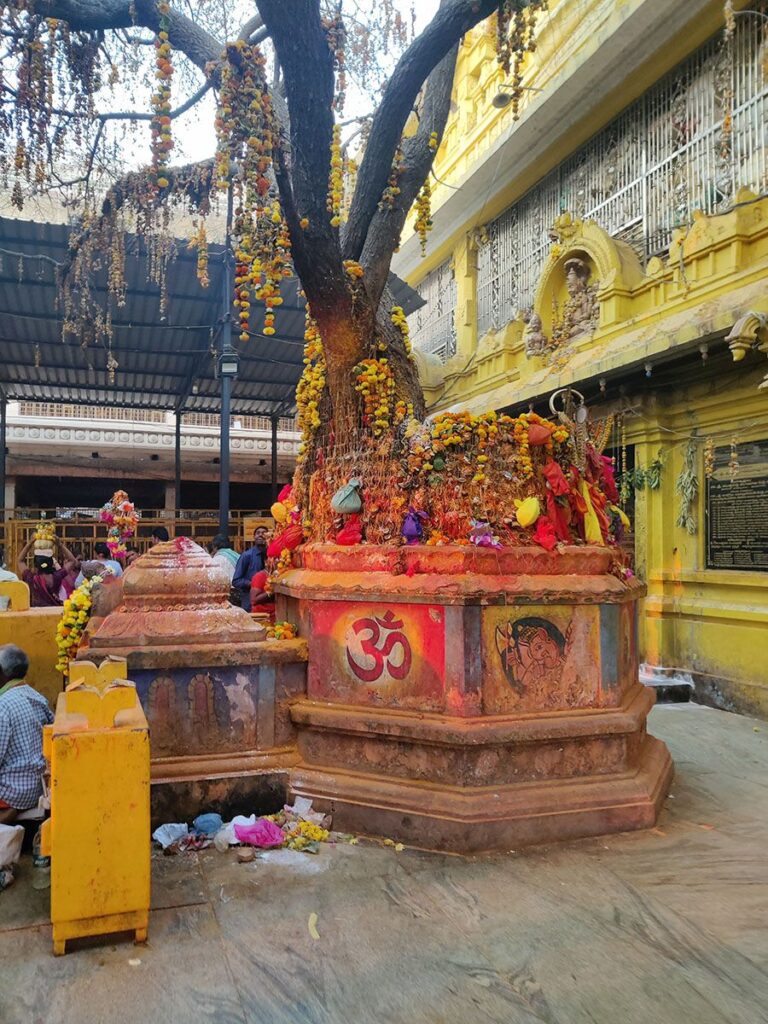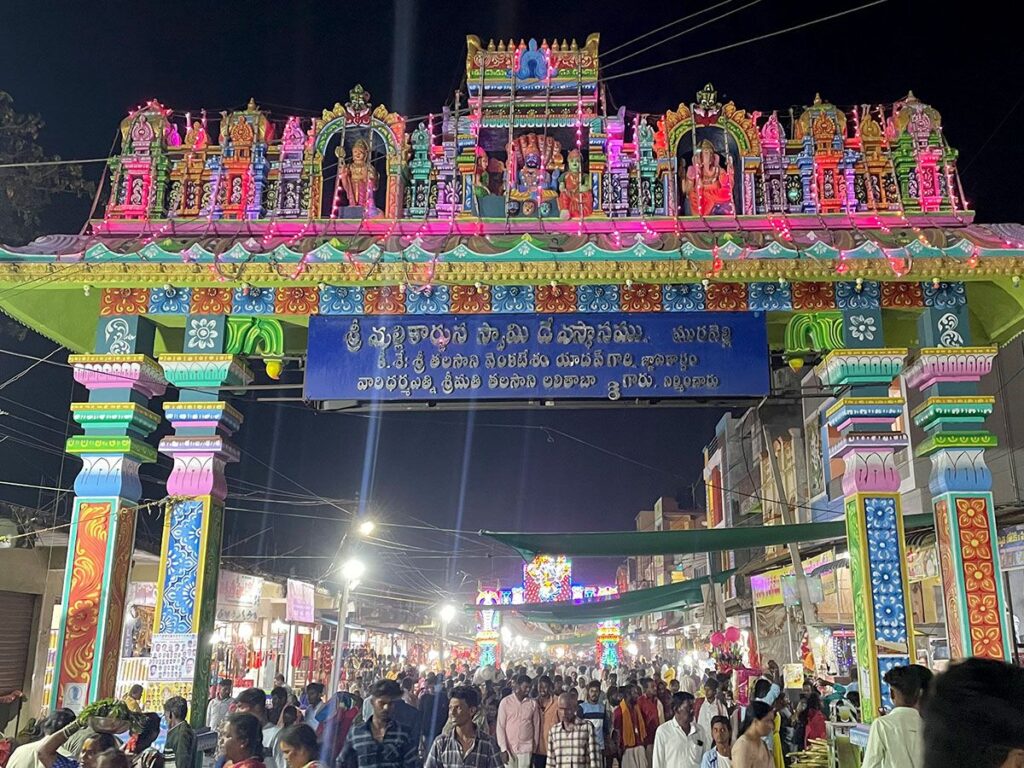Komuravelli Mallanna Temple
The Komuravelli Mallanna Temple is a Hindu temple located on a hill in Komuravelli village of Siddipet district in Telangana state, India. It is dedicated to Lord Shiva, also known as Mallanna, a folk deity of Telangana. The temple is a popular pilgrimage destination for devotees from all over the state.

Contents
- 0.1 Origins shrouded in mystery:
- 0.2 Architectural blend:
- 0.3 The fierce deity and his consorts:
- 0.4 Unique traditions and rituals:
- 0.5 Annual Jathara:
- 1 Legend of Komuravelli Mallanna Temple:
- 2 Significance of Komuravelli Mallanna Temple:
- 3 Myths and Beliefs of Komuravelli Mallanna Temple:
- 4 Komuravelli Mallanna Temple Timing and Rituals:
- 5 Places to visit near Komuravelli Mallanna Temple:
- 6 FAQ:
- 6.0.1 1. What is Komuravelli Mallanna Temple?
- 6.0.2 2. When was Komuravelli Mallanna Temple built?
- 6.0.3 3. What is the significance of Komuravelli Mallanna Temple?
- 6.0.4 4. What are the main features of Komuravelli Mallanna Temple?
- 6.0.5 5. What are the festivals celebrated at Komuravelli Mallanna Temple?
- 6.0.6 6. How to reach Komuravelli Mallanna Temple?
- 6.0.7 7. How to visit Komuravelli Mallanna Temple?
- 6.0.8 8. What is the story of Mallanna?
- 6.0.9 9. What is komuravelli famous for?
- 7 How to reach Komuravelli Mallanna Temple:
- 8 Google Maps:
Origins shrouded in mystery:
The exact origins of the temple remain shrouded in mystery. Legends speak of a tribal chieftain named Komuravelli Mallanna, known for his bravery and righteousness. He’s said to have resided in the caves where the temple now stands, using them as a hideout during battles against oppressive rulers. After his death, the caves became a place of worship, eventually transforming into the temple we see today.
Architectural blend:
The temple showcases a captivating blend of architectural styles, reflecting the region’s rich cultural tapestry. The Kakatiya and Chalukya influences are evident in the intricate carvings, sculptures, and pillars. The sanctum sanctorum, where the main deity resides, is carved into the natural cave itself, adding a unique touch to the temple’s ambiance.
The fierce deity and his consorts:
The main deity worshipped here is Lord Mallikarjuna Swamy, a fierce manifestation of Lord Shiva. He’s depicted with a trident in his hand and a cobra adorning his head, symbolizing his power and dominion over evil. Flanking him are his two consorts, Golla Kethamma and Balija Medalamma, representing different castes and communities, highlighting the temple’s inclusivity.
Unique traditions and rituals:
The Komuravelli Mallanna Temple is renowned for its unique traditions and rituals. Devotees offer prayers with the help of Oggu Pujaris, who draw intricate patterns called Patnam on the floor using rice flour and turmeric. These patterns are believed to carry prayers and offerings to the deity.
Annual Jathara:
The temple comes alive during the annual Komuravelli Mallanna Jathara, a vibrant festival held in January or February. Thousands of devotees flock to the temple to participate in processions, witness cultural performances, and seek blessings from the deity. The festival is a testament to the enduring faith and devotion that the Komuravelli Mallanna Temple continues to inspire.
Read More>> Rajarajeshwara Temple Vemulawada

Legend of Komuravelli Mallanna Temple:
The Enchanting Tale of Mallanna and Medallamma:
The legend revolves around Mallanna, a valiant warrior and ardent devotee of Lord Shiva. He falls in love with the beautiful Medallamma, a celestial being and incarnation of Goddess Parvati. However, her brothers, wary of Mallanna’s mortal status, set him seemingly impossible tasks to prove his worthiness.
Trials and Triumphs:
One challenge involves acquiring “Bandari,” a rare turmeric paste believed to be guarded in a forbidden mosque. Undeterred, Mallanna seeks blessings from Lord Shiva and Ganesha. Following their guidance, he encounters Yellamma, a wise woman who reveals the Bandari’s location. With wit and courage, Mallanna retrieves the Bandari, overcoming obstacles and displaying his unwavering devotion.
Union and Divinity:
Impressed by Mallanna’s determination and love for Medallamma, her brothers finally relent. The divine couple unites, and Mallanna transforms into a manifestation of Lord Shiva himself, worshipped as Komuravelli Mallanna Swamy.
The Temple Atop the Hill:
Legend has it that Komuravelli Mallanna himself consecrated the temple atop the hill, where it stands today. The clay idol of the deity, believed to be centuries old, exudes a powerful aura. Devotees flock to the temple, seeking blessings for various aspects of life, from love and marriage to prosperity and protection.
A Tapestry of Traditions:
The temple complex also houses shrines dedicated to Mallanna’s consorts, Golla Kethamma and Balija Medalamma. The annual Komuravelli Mallanna Jaathara, a vibrant festival, draws devotees from far and wide, celebrating the legend through music, dance, and religious fervor.
Beyond the Legend:
The Komuravelli Mallanna Temple is more than just a place of worship. It’s a testament to the power of love, perseverance, and faith. The legend, passed down through generations, reinforces the values of devotion, courage, and overcoming challenges.
Read More>> Bhadrachalam Temple | Bhadradri Seetha Ramachandra Swamy

Significance of Komuravelli Mallanna Temple:
Religious Significance:
- Dedicated to Lord Shiva: The temple’s primary deity is Mallanna, an incarnation of Lord Shiva, revered for his power, grace, and protection.
- Unique Offerings: Devotees offer prayers with the help of “Oggu Pujaris,” who draw intricate rangolis called “Patnam” as offerings to Lord Mallanna.
- Festivals: The temple is a hub for vibrant festivals like Maha Shivaratri, celebrated with the grand “Pedda Patnam,” and Agni Gundaalu, held before Ugadi.
Cultural Significance:
- Folklore and Mythology: The temple is steeped in folklore and mythology, with stories about Mallanna’s origins and miracles captivating devotees for generations.
- Architectural Marvel: The temple’s architecture, with its unique cave setting and clay idol of Mallanna, stands as a testament to the region’s artistic heritage.
- Social Cohesion: The temple fosters a sense of community, bringing people together for religious ceremonies, festivals, and celebrations.
Historical Significance:
- Ancient Origins: The temple’s origins are believed to date back centuries, making it a historical landmark in the Telangana region.
- Cultural Preservation: The temple’s traditions and practices, like the “Oggu Pujaris” and “Patnam,” preserve and showcase the region’s unique cultural identity.
- Symbol of Resilience: The temple has weathered the test of time, standing as a symbol of the region’s cultural and religious resilience.
Read More>> Dakshin Ke Badrinath Temple Hyderabad

Myths and Beliefs of Komuravelli Mallanna Temple:
1. The Legend of Komuravelli Mallanna:
The central myth revolves around the deity himself, Komuravelli Mallanna. He is believed to be an incarnation of Lord Shiva who took the form of a powerful warrior to protect the region from evil forces. Legend has it that he married a local woman named Golla Kethamma and lived among the people, resolving their problems and safeguarding them from harm. His heroic deeds and divine powers made him a beloved figure, and he is worshipped as a protector and wish-fulfiller even today.
2. The Power of “Patnam”:
A unique ritual practiced at the temple is the offering of “Patnam.” Devotees draw intricate kolams (rangolis) using rice flour and turmeric on the temple floor, each pattern symbolizing a specific wish or prayer. These Patnams are believed to be powerful conduits for communication with the divine, carrying the hopes and aspirations of the devotees to Komuravelli Mallanna.
3. The Fire Walking Ceremony:
During the annual Agni Gundaalu festival, devotees walk barefoot on a bed of burning embers. This fiery ordeal is seen as a test of faith and devotion, and those who successfully complete it are said to be blessed by the deity. The origin of this practice is shrouded in mystery, but it continues to be a spectacular and awe-inspiring spectacle that draws thousands of pilgrims every year.
4. The Oggu Ballads:
The stories of Komuravelli Mallanna are not written down in scriptures but are kept alive through a vibrant oral tradition called Oggu. Oggu Katha singers narrate the tales of the deity’s exploits in a rhythmic and captivating style, accompanied by percussion instruments. These ballads not only entertain but also serve as a way to transmit cultural values and religious beliefs from generation to generation.
5. The Wish-Fulfilling Tree:
Within the temple complex stands a sacred tamarind tree known as the “Mari Chettu.” Devotees tie colorful threads or rags on its branches, each knot representing a wish or prayer. It is believed that the deity grants the wishes of those who offer sincere devotion at the tree.
Read More>> 11th Century Ammapalli Temple of Sri Seetha Rama
Komuravelli Mallanna Temple Timing and Rituals:
Temple Timings:
- The temple is open from 6:00 AM to 8:00 PM.
- Darshan timings are from 6:00 AM to 7:30 PM.
- The temple is closed for darshan during pooja times.
Rituals:
- The main rituals performed in the temple are Abhishekam, Rudrabhishekam, and Sahasralinga Darisanam.
- Abhishekam is a ritual in which the idol of the deity is bathed with milk, water, and other sacred items.
- Rudrabhishekam is a more elaborate ritual in which the idol of the deity is bathed with 11 different types of liquids.
- Sahasralinga Darisanam is a ritual in which devotees view 1008 lingams (symbols of Lord Shiva).
Places to visit near Komuravelli Mallanna Temple:
- Kondapochamma Sagar Reservoir: This reservoir is located near Siddipet and offers a picturesque setting. You can enjoy the scenic views and perhaps take a boat ride if available.
- Jagannath Temple, Wargal: Wargal is known for the Sri Lakshmi Narasimha Swamy Temple, also known as the Wargal Saraswati Temple. It’s dedicated to Goddess Saraswati and is a popular pilgrimage site.
- Medak Cathedral: If you’re interested in historical and architectural sites, the Medak Cathedral is a noteworthy landmark. It’s one of the largest churches in India and has a unique architecture.
- Kaleswaram: Located on the confluence of the Godavari River and its tributary, the Pranahita River, Kaleswaram is known for its ancient Shiva temple and the Kaleswaram Barrage. The surroundings are scenic and culturally rich.
- Ramagundam: If you’re interested in industrial tours, Ramagundam is known for its coal mines and thermal power stations. It’s an industrial town and could be of interest to those curious about the energy sector.
- Warangal: Though a bit farther away, Warangal is known for its rich historical heritage. The Warangal Fort, Thousand Pillar Temple, and the Kakatiya Kala Thoranam are some of the prominent attractions.
- Bhadrakali Temple, Warangal: This temple is dedicated to Goddess Bhadrakali and is a significant pilgrimage site in the region.
FAQ:
1. What is Komuravelli Mallanna Temple?
Komuravelli Mallanna Temple is a Hindu temple dedicated to the god Mallanna, a folk deity of Telangana. The temple is located in the Komuravelli village of the Jagtial district of Telangana, India.
2. When was Komuravelli Mallanna Temple built?
The exact date of construction of the Komuravelli Mallanna Temple is unknown. However, it is believed to have been built in the 16th century during the reign of the Kakatiya dynasty.
3. What is the significance of Komuravelli Mallanna Temple?
Komuravelli Mallanna Temple is a popular pilgrimage destination for Hindus in Telangana. The temple is believed to be a powerful center of worship and is said to grant wishes to those who pray to Mallanna.
4. What are the main features of Komuravelli Mallanna Temple?
The main temple structure is a two-tiered tower with a dome on top. The tower is made of red sandstone and is decorated with intricate carvings. The temple also has a large courtyard with a pond in the center.
5. What are the festivals celebrated at Komuravelli Mallanna Temple?
The main festival celebrated at Komuravelli Mallanna Temple is the Mallanna Jatara, which is held in the month of March. The festival is a week-long celebration with music, dance, and religious ceremonies.
6. How to reach Komuravelli Mallanna Temple?
Komuravelli Mallanna Temple is located about 100 kilometers from Hyderabad. The temple is well-connected by road and rail. By road, the temple can be reached by taking the Hyderabad-Bangalore highway. By rail, the nearest railway station is the Jagtial railway station.
7. How to visit Komuravelli Mallanna Temple?
The temple is open to the public from 6:00 AM to 8:00 PM. The best time to visit the temple is during the morning or evening hours when the weather is cooler.
8. What is the story of Mallanna?
The story of Mallanna is a fascinating and multifaceted one, passed down through generations in the form of “Oggu Katha,” a traditional storytelling practice in Telangana. While there are variations, here’s a concise summary:
Early Life and Challenges:
- Mallanna was born into a Golla (shepherd) family in the village of Komuravelli. He was known for his strength, kindness, and devotion to Shiva.
- Mallanna faced several challenges in his youth. He was once falsely accused of theft and exiled from the village. He also encountered bandits and wild animals during his travels.
Meeting Medalamma:
- Mallanna’s life took a pivotal turn when he met Medalamma, a beautiful and powerful goddess. She was impressed by his bravery and resilience but set difficult conditions for their marriage.
- These conditions included fetching water from seven rivers, climbing a slippery pole, and defeating seven bulls in a wrestling match. Mallanna, with his unwavering determination and divine help, overcame each challenge.
Marriage and Legacy:
- Mallanna and Medalamma’s wedding was a grand celebration, attended by gods and goddesses. They lived happily ever after, and Mallanna became a revered deity himself.
- Mallanna’s story symbolizes overcoming adversity, the power of love and devotion, and the importance of keeping one’s promises. His legacy lives on through the Komuravelli Mallanna Temple and the vibrant traditions of Telangana.
9. What is komuravelli famous for?
Komuravelli is famous for two main things:
1. Komuravelli Mallanna Temple: This Hindu temple dedicated to Mallanna, a folk deity of Telangana, draws millions of pilgrims every year. The temple is renowned for its powerful deity, vibrant festivals, and traditional “Oggu Katha” storytelling that preserves Mallanna’s fascinating life story.
2. Komuravelli Mallanna Jaathara: This week-long festival held in March is a vibrant celebration of Mallanna’s life and legacy. It features music, dance, religious ceremonies, and a chariot procession, attracting devotees from across Telangana and beyond.
How to reach Komuravelli Mallanna Temple:
- By Air: The nearest airport is Rajiv Gandhi International Airport in Hyderabad, which is well-connected to major cities in India and around the world. From the airport, you can hire a taxi or use other modes of transportation to reach Komuravelli.
- By Train: The nearest railway station is Siddipet Railway Station. From the railway station, you can hire a taxi or use local transportation to reach the temple.
- By Road:
- From Hyderabad:
- Komuravelli Mallanna Temple is approximately 90 kilometers away from Hyderabad. You can take a car or hire a taxi to reach the temple. The journey may take around 2-3 hours depending on traffic conditions.
- Alternatively, you can use public buses that operate between Hyderabad and Siddipet. From Siddipet, you can hire a taxi or take a local bus to reach Komuravelli.
- From Siddipet:
- If you are coming from Siddipet, you can hire a taxi or use local transportation to reach Komuravelli Mallanna Temple, which is around 15 kilometers away.
- From Hyderabad:
